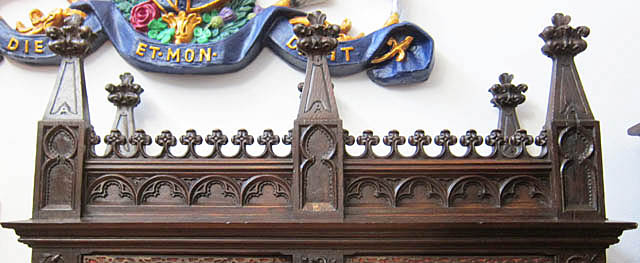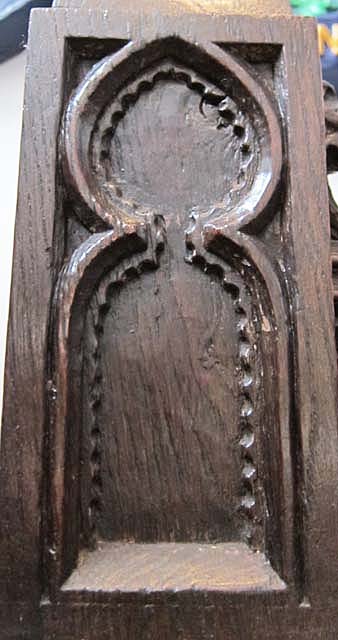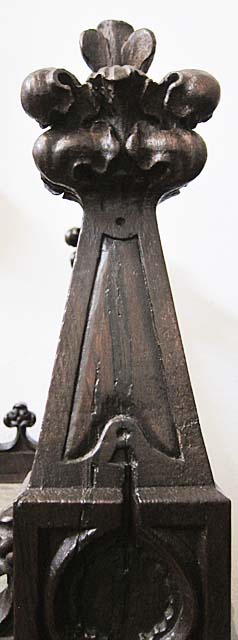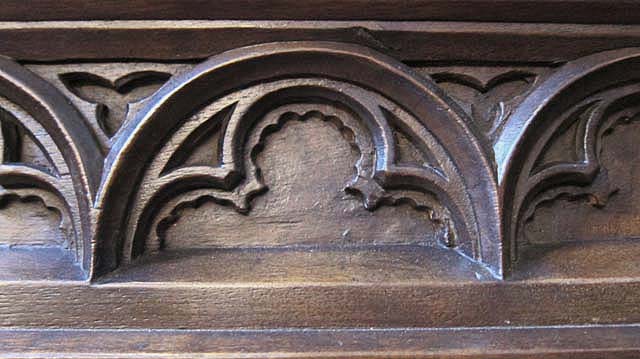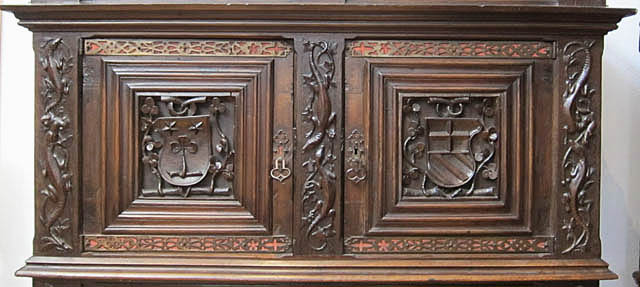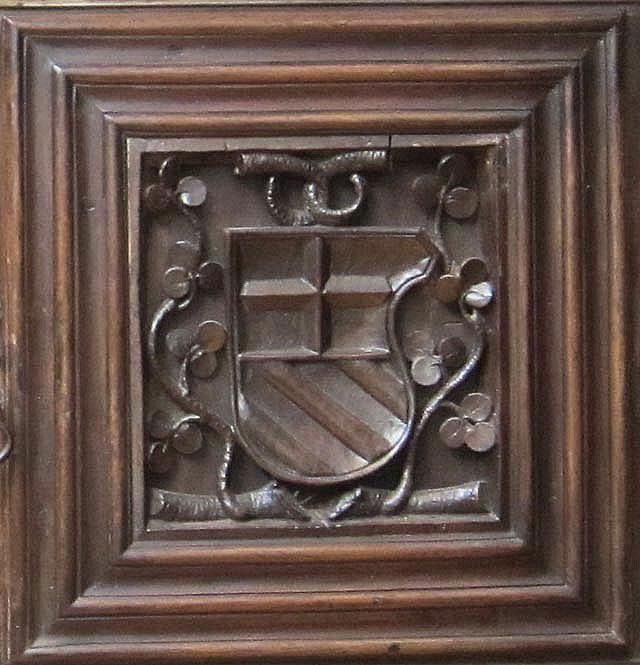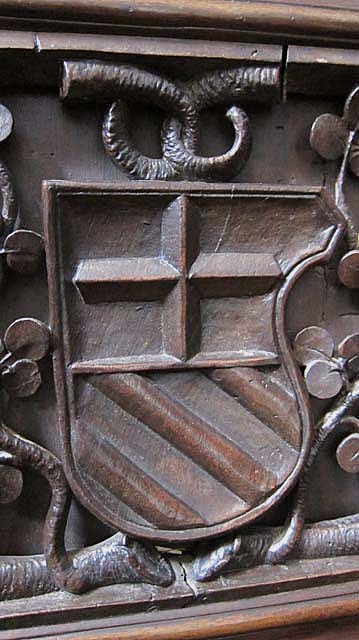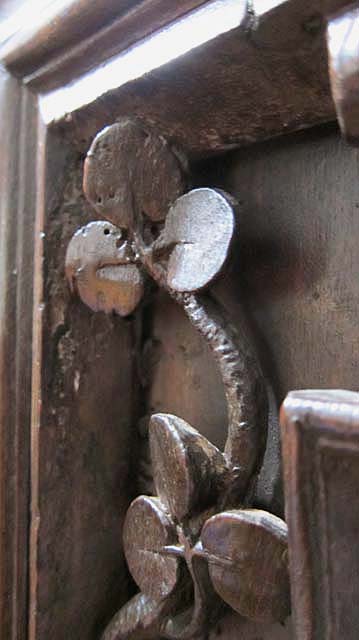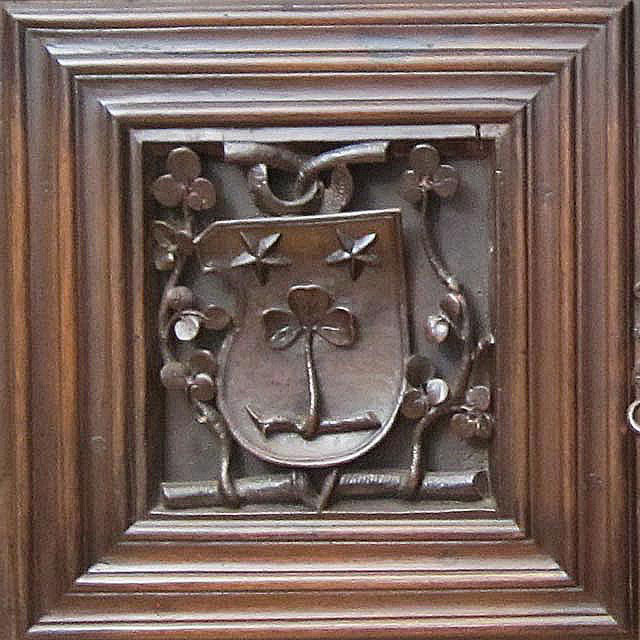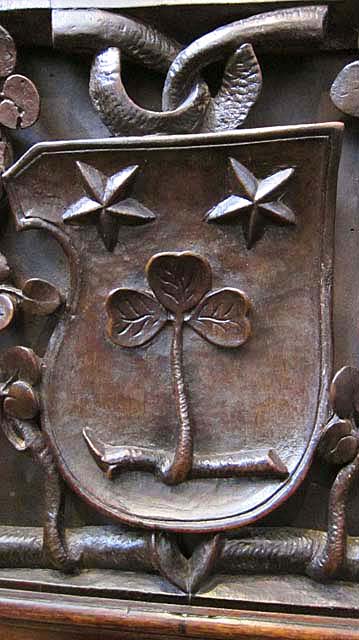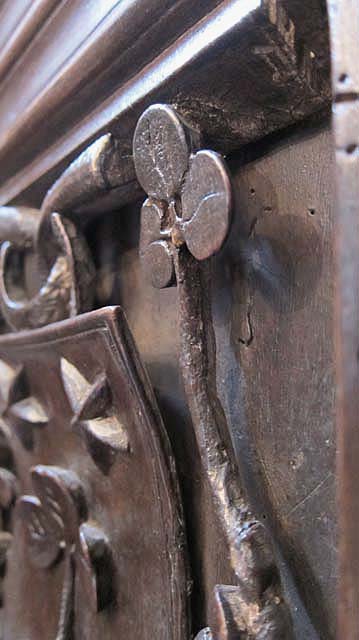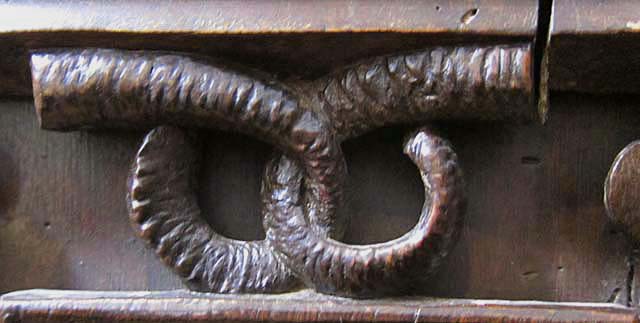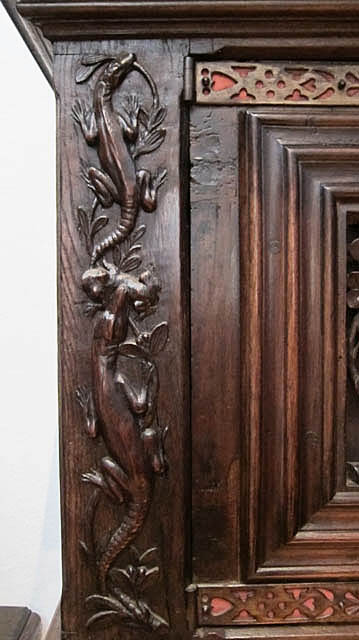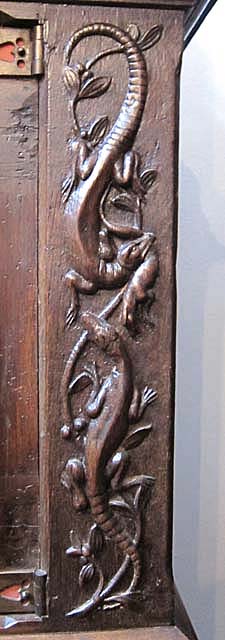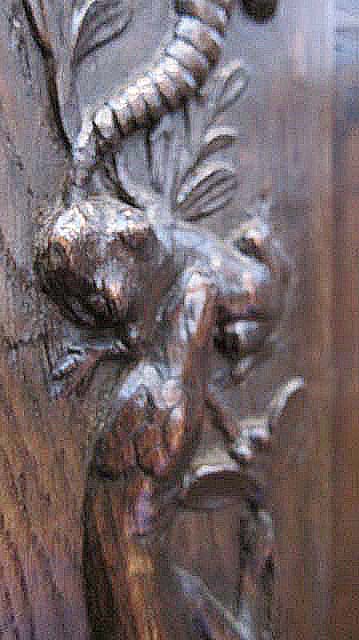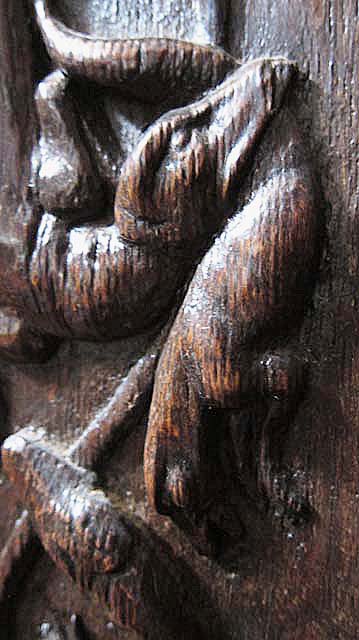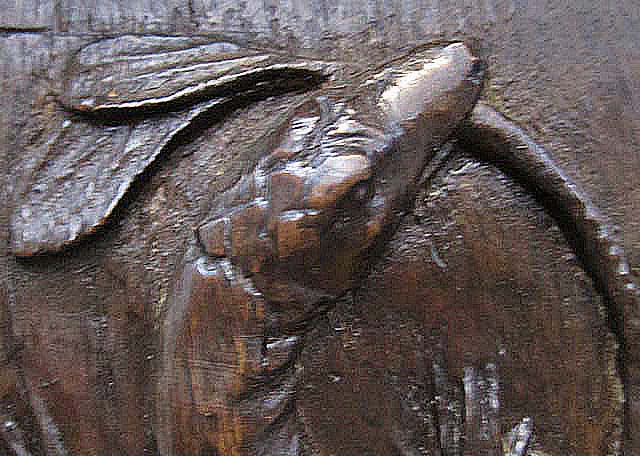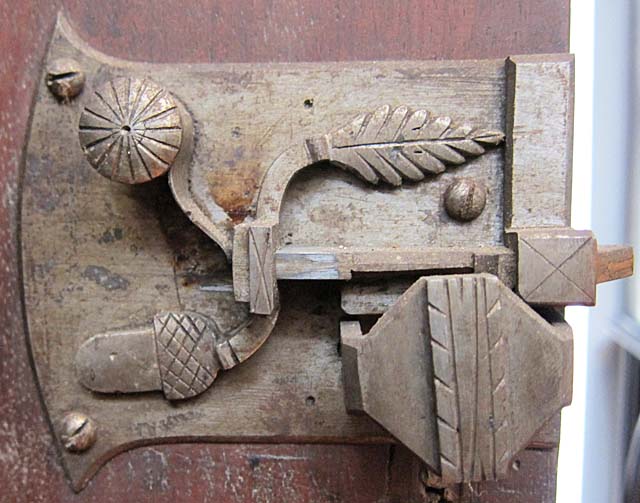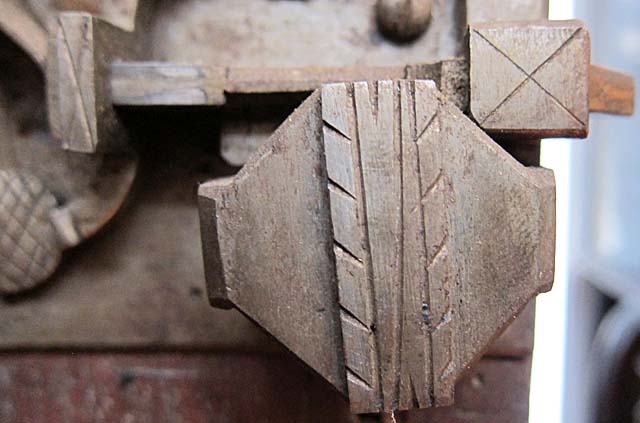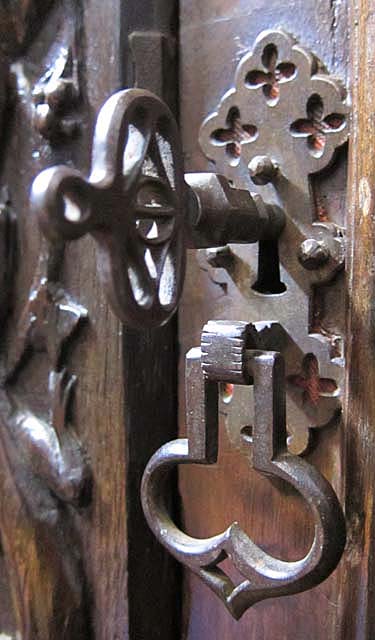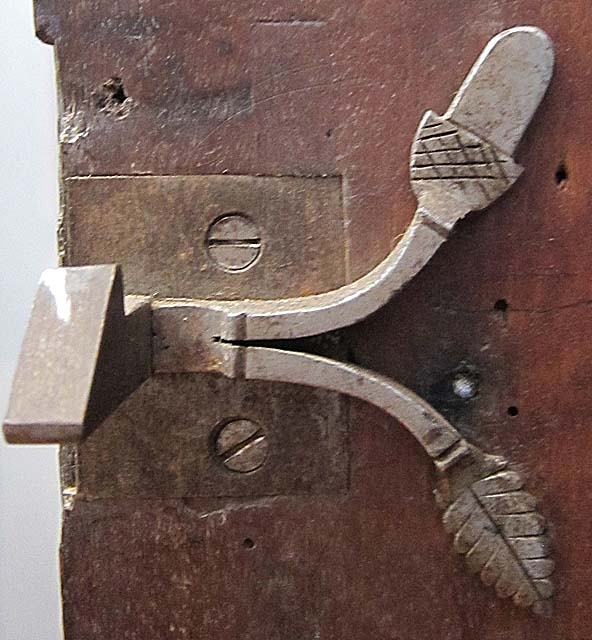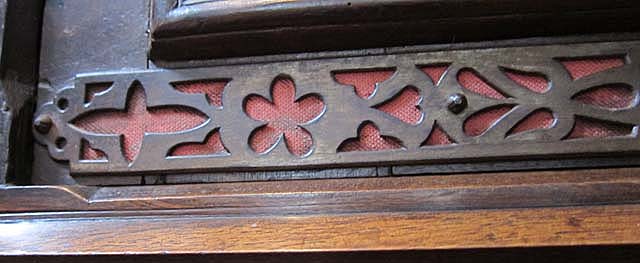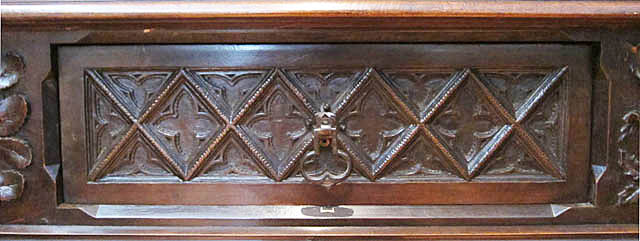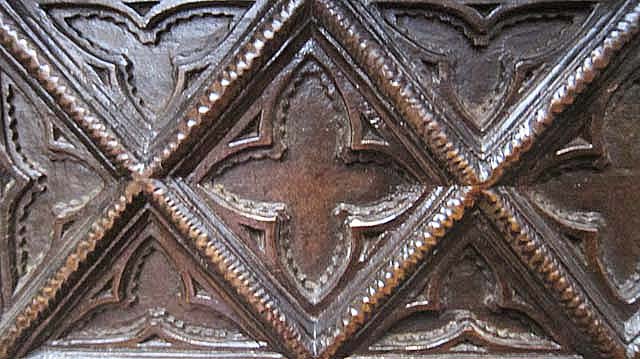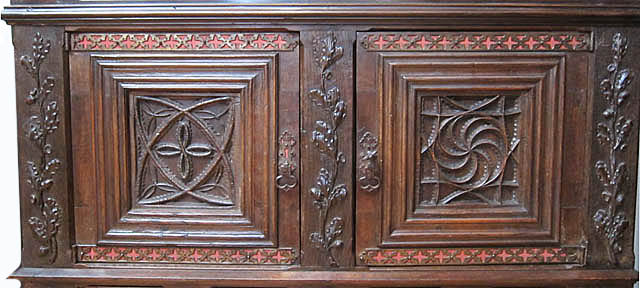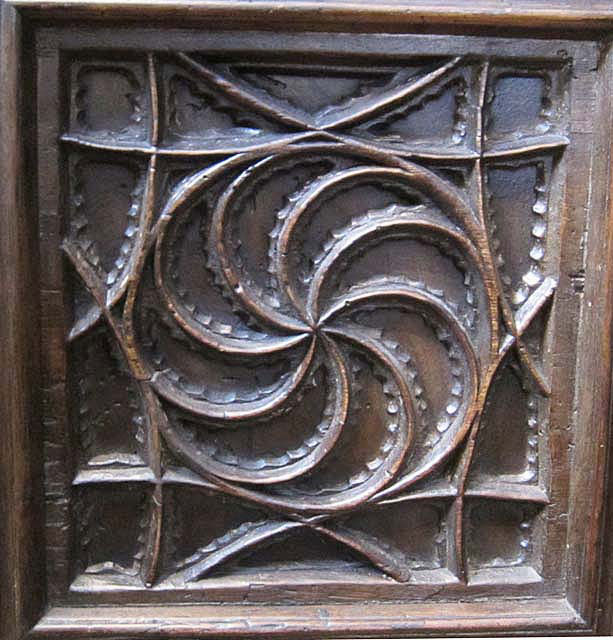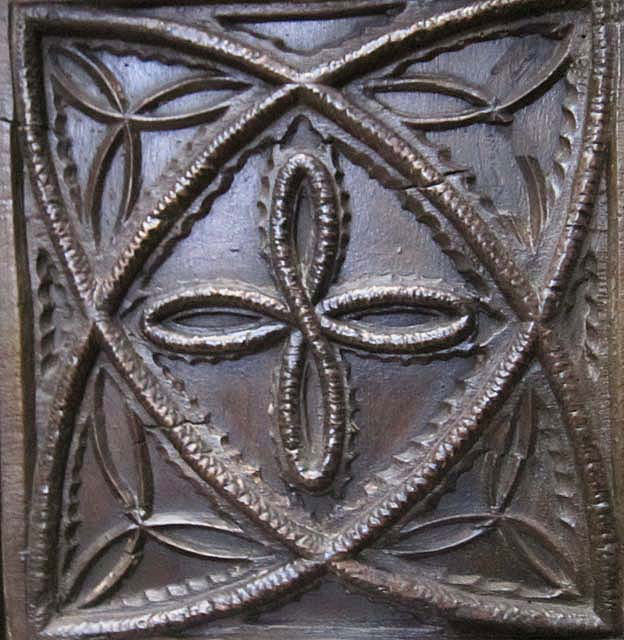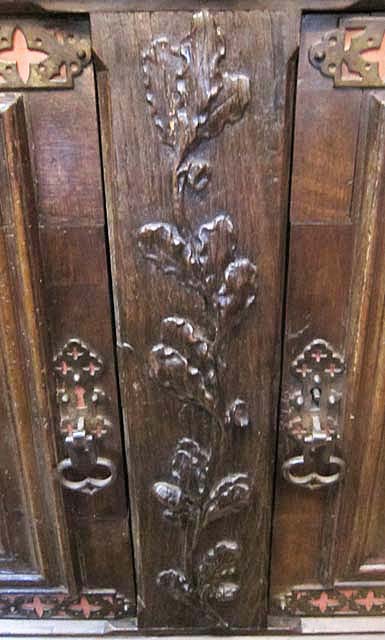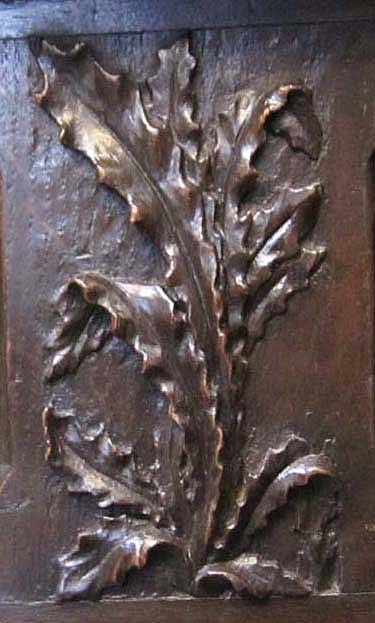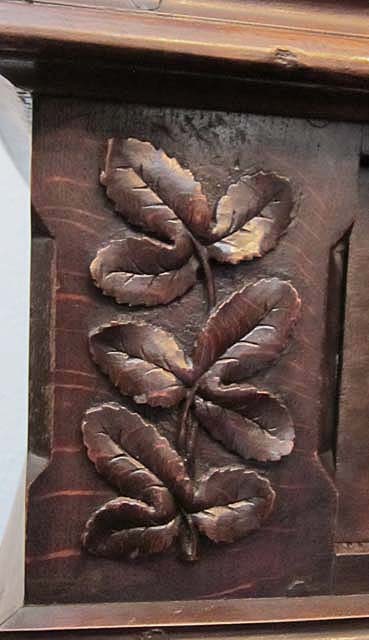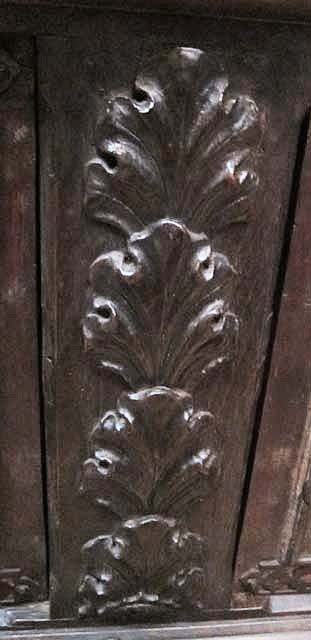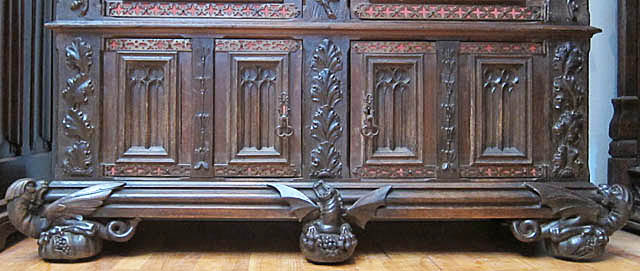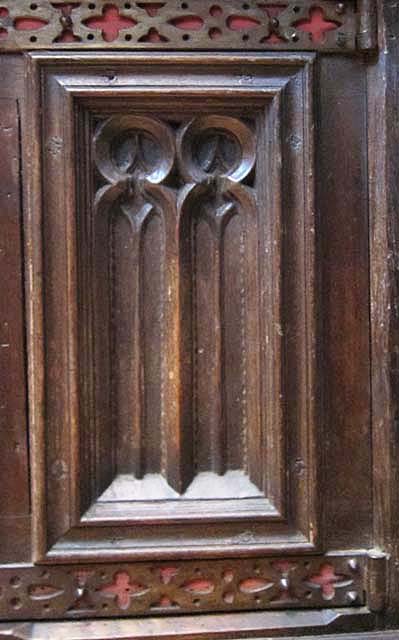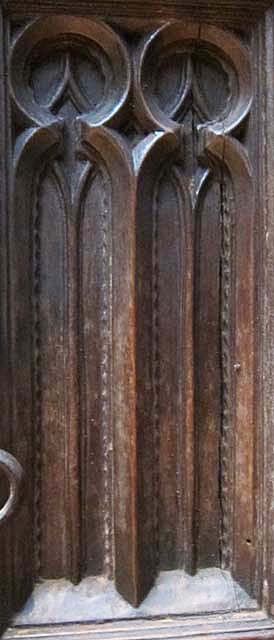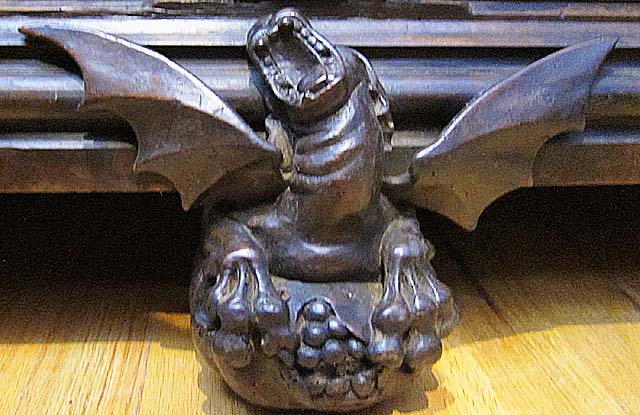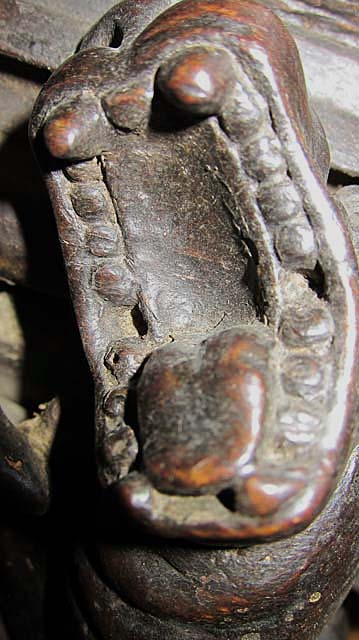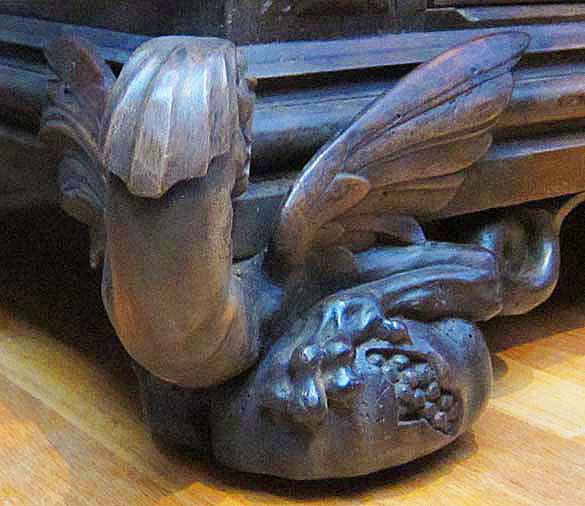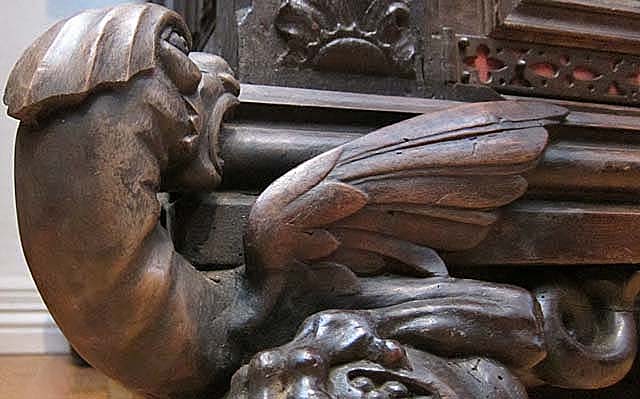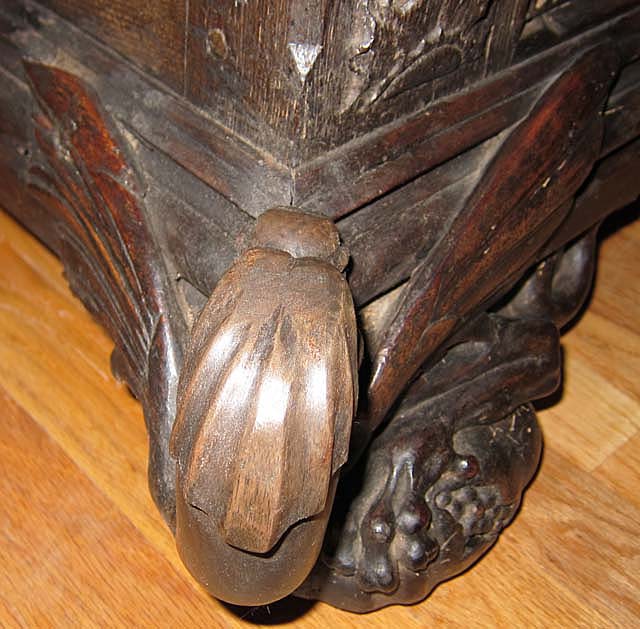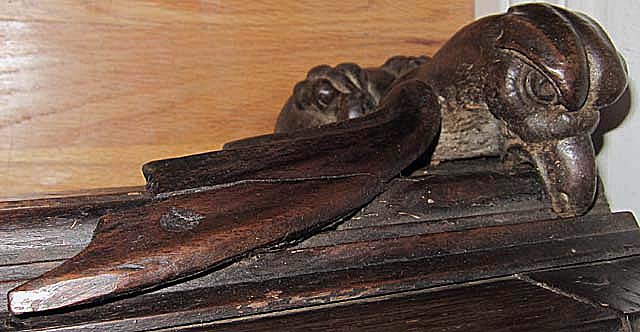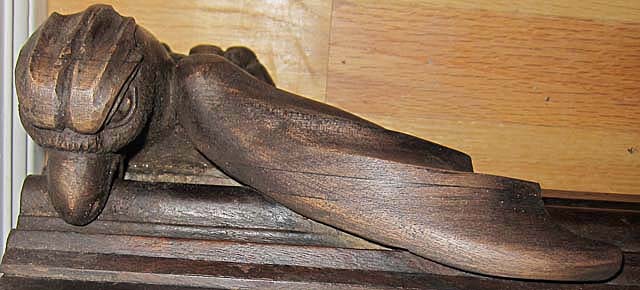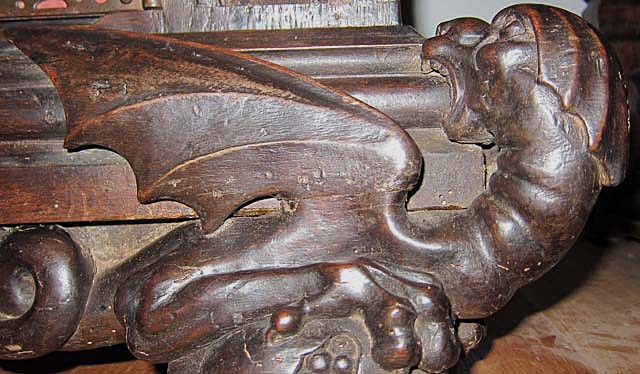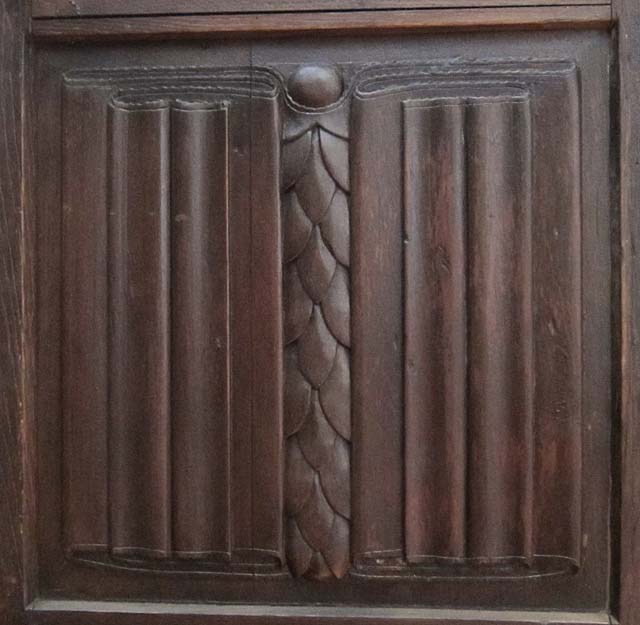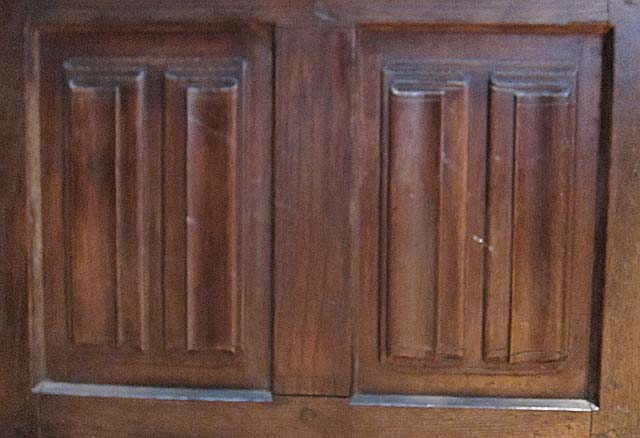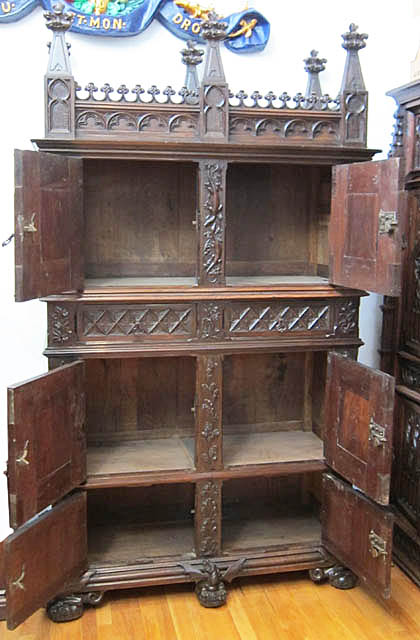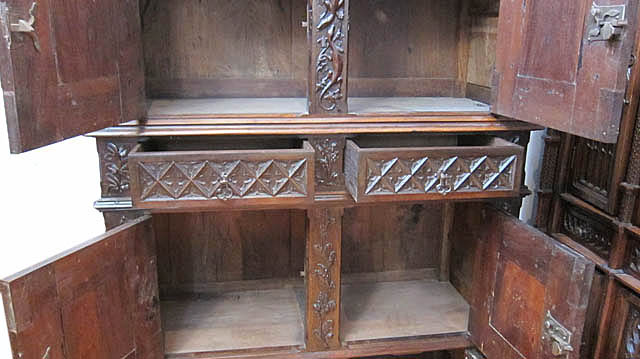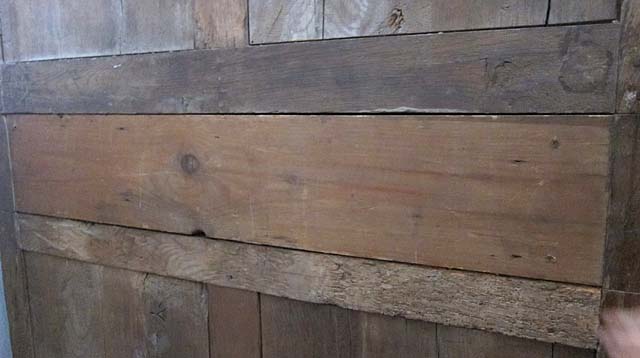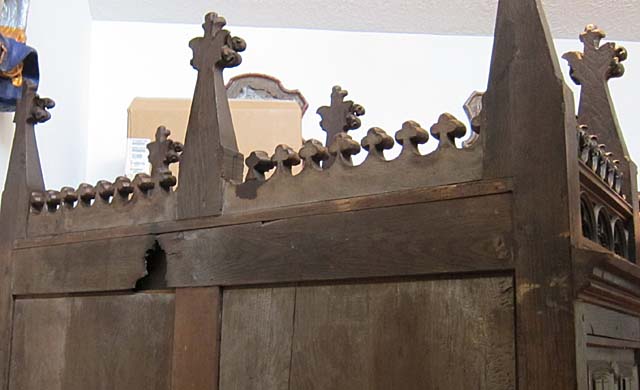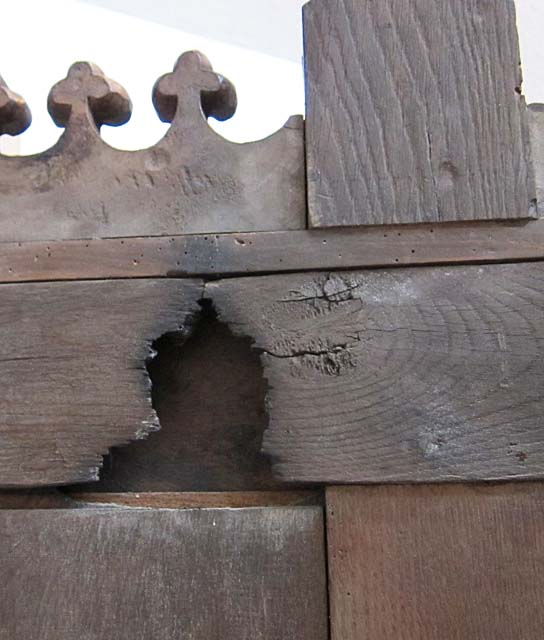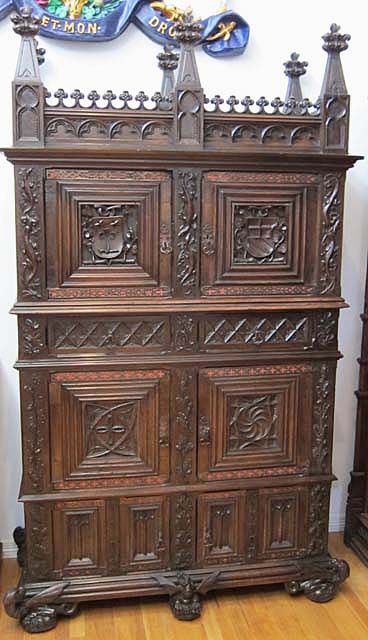
When choosing furniture in France for our business, we’re attracted by mysteries and enigmas such as the many wrapped up within this piece. Sometimes more questions are raised than can be answered when centuries separate an item’s creation from its arrival at M. Markley Antiques. This description explains what we know about this massive cabinet, made from solid oak and walnut, and suggests why future owners may find it as enchanting as we have.
The basic architecture is one of stiles and rails. The stiles or vertical skeleton of the piece are oak and appear to run the entire length of the cabinet when it is erected. The rails or horizontal skeleton are walnut. In between are panels or drawers, also of walnut.
This combination of oak and walnut is an interesting choice. The oak is sturdier for purposes of support and overall framework but the walnut is more finely grained and receptive of intricate carving. This leads us to conclude it was designed for an important and enduring reason (more about that, below).
Instead of two case pieces comprising a typical bahut deux-corps, the cabinet consists of three weighty pieces: bottom case (comprising two levels of cabinet space), middle section for drawers, and top case including an elaborate crown. Thankfully, the three components securely align owing to an ingenious internal system of cross-shaped vertical members that unite all three levels through openings on both sides.
While the cabinet’s style is undeniably Gothic it is not typically so. Long on Gothic elements such as linenfold patterns it is short on arches and tracery or fenestrage. The large format linenfold panels on the upper portions of the sides of the cabinet are unusual due to the intricately carved vertical piece uniting the two lobes. Other linenfold panels are less elaborate, such as the smaller, horizontal ones and simple vertical ones on the lower part of the sides of the cabinet.
Known in French as the plis-de-serviette or plis-de-parchemin, this motif dates back to the Middle Ages in Flanders (now northeastern France and western Belgium) as a simple, easily-crafted yet elegant way to fill blank spaces. At that time, the nomenclature was Latin (lignum undulatum or wavy wood) but took on textile nomenclature during the 19th century revival of interest in Gothic design. While common in French furniture and interior decoration such as wood paneling or wainscoting, this motif crossed the Channel in Tudor times and can even be glimpsed during broadcasts of Downton Abbey!
The Gothic or simple pointed arch is something we expect to see in Gothic style furniture of the 19th century, not only as an architectural feature but also as the framework for intricate tracery. Such an arch is missing entirely from this cabinet which uses instead a lancet arch — the variation on the Moorish or horseshoe arch found in the architecture of regions remote from France. For more about this arch, see the section on Gothic in Stylistic Origins.
Such an arch is seen more commonly in Gothic design as a variation of the lancet or extremely tall and thin arches supporting more elaborate designs such as quatrefoils and rose window patterns. This arch shape is also found on the door panels of the lowest part of this cabinet, where it more closely resembles the lancet arch. Did the person who commissioned this work have a fascination with Moorish architecture based on travels to Spain or the Levant? Was it built to house treasures acquired there? Does the cabinet predate the 19th century revival of interest in Gothic design, before the efforts of Eugène Viollet-le-Duc made elements such as the Gothic arch more popular?
The topmost portion of this piece is its most affirmatively Gothic, offering tracery in the form of lunettes or a half-moon design above which sits a border of trefoils resembling those used in monarchs’ crowns. Finials mark the mid-point of the front and the four corners. They hearken back to the late Gothic or flamboyant (flaming) style of architecture and furniture with flame-like figures at their apex.
The panels just below the drawers contain Gothic elements but again they are not typical of Gothic revival in the 19th century as seen in cabinet 5112A. The right door has a pinwheel motif evocative of a Catherine Wheel, or perhaps a rose window, and surrounded by nondescript shapes. The left door has a central quatrefoil comprised of two intersecting tori or endless loops within a larger design of intercepting ellipses. Surrounding it are trefoils involving slender, looping elements.
The drawers at the mid-section display a Gothic theme comprised of repeating diamond-shaped patterns, each with a quatrefoil inside, and separated by trefoils. The inner border of each quatrefoil and trefoil is a sawtooth pattern as if cut by a pinking shear. The same serrated motif is found on the inner borders of other shapes on this cabinet, including the Moorish arches, and the lunettes on the top, as well as the elements of the door panels mentioned in the previous paragraph. This decorative detail, so unifying of the various motifs on this cabinet, is not characteristic of Gothic revival in the 19th century and reinforces our conclusions that the cabinet predates this style and reflects the unique vision of its creator.
We believe this piece was commissioned for a marriage, due to the coats-of-arms on the two doors of the topmost cabinet section. It was not unusual in France of centuries past for families united in marriage to memorialize the event with furniture personalized for the participants. We still have the first piece of antique furniture we ever bought as newlyweds living in Paris – a 19th century Breton cabinet with the portrait of the husband and wife carved from the magnificent chestnut wood.
Given the importance and princely pricing of hand-made textiles such as tablecloths, napkins, and bed linens in the culture of Europe before industrialized weaving, such prized wedding gifts would likely find a home in a cabinet such as this one under lock and key. Safeguarding their gifts in a massive and beautifully carved cabinet would symbolize the commitment of the married couple and dedication to a long life together. Gazing daily at a cabinet emblazoned with their coats-of-arms would provide meaningful reinforcement of their union and their families’ importance to it
Research has not revealed the identities of the families associated with the coats-of-arms. It could be that the last descendants are long gone and the heraldry is no longer used. Both coats-of-arms take as the basic shape of their shield or escutcheon a form known in French as à bouche, or the curved section on the side of a shield used by a knight for resting his lance when going into battle. Both escutcheons are surrounded by vines with trefoils, perhaps a unifying heraldic symbol of the two families. Carved away from the wood panel far enough for a finger to curl around the stems, the vines represent exceptional carving while reinforcing the notion of a cabinet commissioned for a special occasion. We have seen this type of virtuoso carving in other pieces such as the 18th century oak columns we sold several years ago (Item 4165). Easily damaged, the carvings are intact except for one missing leaf on the left panel.
The coat-of-arms on the right incorporates a cross in the upper part and three diagonal bars in the lower part. The one on the left upper door of the cabinet consists of a trefoil or cloverleaf, emerging from a tree branch, with a five-pointed star on either side. Both shields have a knot on the top (perhaps a French reference to a wedding?)
One of several mysterious aspects of this cabinet is the animal symbolism. On the front stiles of the uppermost portion are carvings of lizards intertwined with sprigs of vegetation. Despite the hardness of the oak, these figures are intricately carved and with toes as delicate as those of the little green lizards that sun themselves on our patio. Whether the lizards are meant to allude to other elements of the cabinet is unclear but the intricacy of their carving and the activities depicted lead us to think they are central to understanding the cabinet and were meant as more than mere decorative elements.
On the left stile, both lizards appear to be scampering toward the top of the cabinet but the lower one has a frog in its mouth and the upper one has a twig. On the right stile, the lizards are slithering vertically toward each other and the uppermost one has a creature in its mouth, possibly a rodent? The central stile shows the lizards coming together in the middle, entwined with vines bearing grape leaves.
We see no reason to associate these lizards with their cousin, the salamander and emblem of King François I, emblazoned throughout castles such as Blois, Chambord, and Fontainebleau. The salamander had a significance all its own as the indefatigable creature capable of being flung into a fire yet not be consumed. They are typically depicted with their tails coiled around them and with flames shooting from their backs or their mouths.
We consider that the lizards carved on this cabinet are less heroic and could represent eternal life — although not for the frog and rodent they have seized! It was believed in medieval times that because its tail would grow back after being lobbed off, the lizard symbolized rebirth and salvation.
At the four corners of the base of this cabinet are perhaps its most interesting feature -- winged creatures with large teeth, huge lizard-like toes and a long, thin tail. They appear to be chomping down on the bottom moulding of the cabinet as if about to levitate it in concert. There is also one in the middle, contorted and with its mouth wide open as if wailing – teeth and tongue intricately and realistically carved.
We believe these creatures are basilisks, a mythical and aggressive beast prized for protecting its territory. A particularly fearsome basilisk is the symbol of the city of Basel, Switzerland. Another version guarded Hogwarts School of Harry Potter fame. Being mythical, there is no standard version of what a basilisk looks like and so the creator of the ones on this cabinet was able to use his fertile imagination. Some more closely resemble lizards while others appear closer to birds.
We ran across a lovely pair of basilisks on a piece of Urbinoware in the collection of the Philadelphia Museum of Art. Whoever wrote a description of the plate apparently was not familiar with the creature and did not identify it as such in the description. With the head of an eagle and the tale of a serpent, it fits the bill as a basilisk.
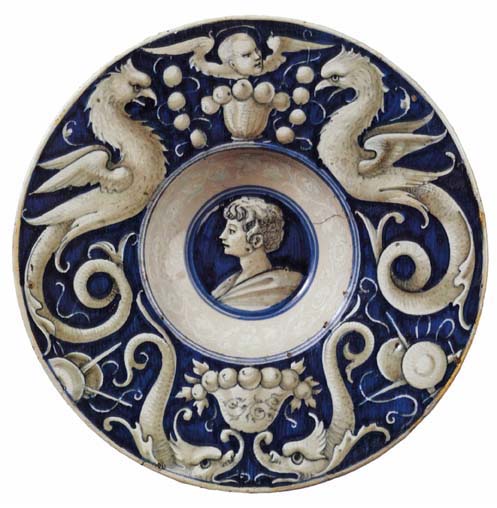
According to legend, a basilisk is hatched on a dung hill from an egg laid by an aging rooster and can slay its adversaries with a glance or an exhalation. It also has wings like a dragon and the head of a bird, sometimes with a crest on top. Its feet can resemble those of a chicken or can be webbed liked a reptile’s.
The figures along the base of this cabinet are exquisitely carved from walnut, each one with a slight variation of design for head and wings. Tucked underneath each one is a long, thin tail and legs poised for springing upward, ending in feet like a lizard’s. Could the innocuous-looking lizards from the top of the cabinet have morphed into these fearsome guardians of furniture?
While reading Antonia Fraser's biography of Mary, Queen of Scots we found a quotation from a letter sent by an imprisoned Mary to her half-brother James mentioning both a basilisk and a lizard (chameleon) in one sentence. “I am not of the nature of the basilisk and less of the chameleon, to turn you to my likeness.” As a result of our antiques being featured in Reign, a series on the CW network about Mary's teenage years in France, including her time as queen of France during the brief reign of her husband, Francis II, we have taken an interest in learning more about Mary and have traveled to her former homes both in France and Scotland. It is tempting to speculate that the designer of this cabinet knew Mary's story and there was some connection to the depiction of lizards and basilisks, it may be pure coincidence -- intriguing in any event.
There are several characteristics that lead us to think that the cabinet is older than the seller’s estimate of 1890. The first is the extensive use of chevilles or wooden dowels employed since the Middle Ages to rely on the laws of physics when ramming a square peg into a round hole and creating the most enduring of fasteners.
The second is the age of the locks for all three cabinet spaces. According to our expert, they are of a complexity and artistry common in the 17th and 18th centuries but not afterward. Particularly unusual is the automatic mechanism that locks the doors upon closing, without the need for a key. The locks are works of art in their own right, made of castings featuring acorns and oak leaves, as shown in the photos, below. It is a shame to keep them hidden. The locks and the sole key are original.
Not part of the original hardware is a device attached to the right side of the cabinet’s uppermost interior and which appears to involve some ancient form of telephone. It has not been removed by us and should involve no impediment to the cabinet’s function.
Some restorations and repairs have been done but predate our acquisition of the cabinet. For example, wood has been replaced on the back in the middle section, as shown in the photo, below.
A final mystery confronts us with respect to the hole at the uppermost back of the cabinet. It is of an irregular shape, approximately 4 inches high and about 3 inches at its widest spot. Perhaps it admitted the wire for the device described, above, but it is not possible to tell. A wooden panel covers the hole from the inside making it invisible from that viewpoint while preventing anything from entering the cabinet from the rear. With that in mind, we can only speculate that the original hole would have been suitable for lizards, but not basilisks, to enter and make themselves at home!
As we write about this remarkable piece, we are reminded of the exquisite craftsmanship of centuries past when things were made by hand and assembled painstakingly in a workshop, not a factory. The goal was that furniture would remain in use, in the same house or castle and by the same family, and be treasured for centuries. That this piece is in excellent condition, especially given the potential damage to the basilisks if the base were moved carelessly, leads us to think it has had just such an experience. We hope its next owner will feel a similar sense of dedication toward it.
The mythical creatures at the base of this cabinet are what initially enthralled us and spurred the acquisition. They continue to fascinate. We have never seen anything like them. While we may never divine the reason for their presence, they will continue to captivate us while we remain thankful for this extraordinary product of an anonymous craftsman’s imagination and artistry.
The most representative color, given the challenges of photographing dark furniture, is in the image at the top of this page.
Reference
Boccador, Jacqueline, Le Mobilier Français du Moyen Age à la Renaissance (Editions d'Art Monelle Hayot, Saint-Just-en-Chaussée, 1988); Faton-Boyancé, Jeanne (Ed.), Le Symbolisme du Bestiaire Médiéval Sculpté (Editions Faton, Dijon, 2010); Thirion, Jacques, Le Mobilier du Moyen Age et de la Renaissance en France (Editions Faton, Dijon, 1998); Vanlian, Laurent and Cédric Curien, Dream of the Dragon (Arts Asiatique, Paris, 2012); Viollet-le-Duc, Eugène, Le Mobilier Médiéval (Georges Bernage, editor) (Editions Heimdal, 2003)
Uses
This cabinet would be ideal in so many places, from a living room or dining room to a bedroom, entryway, or office – anywhere it could be regarded often and delight could be taken in its beauty and uniqueness.
